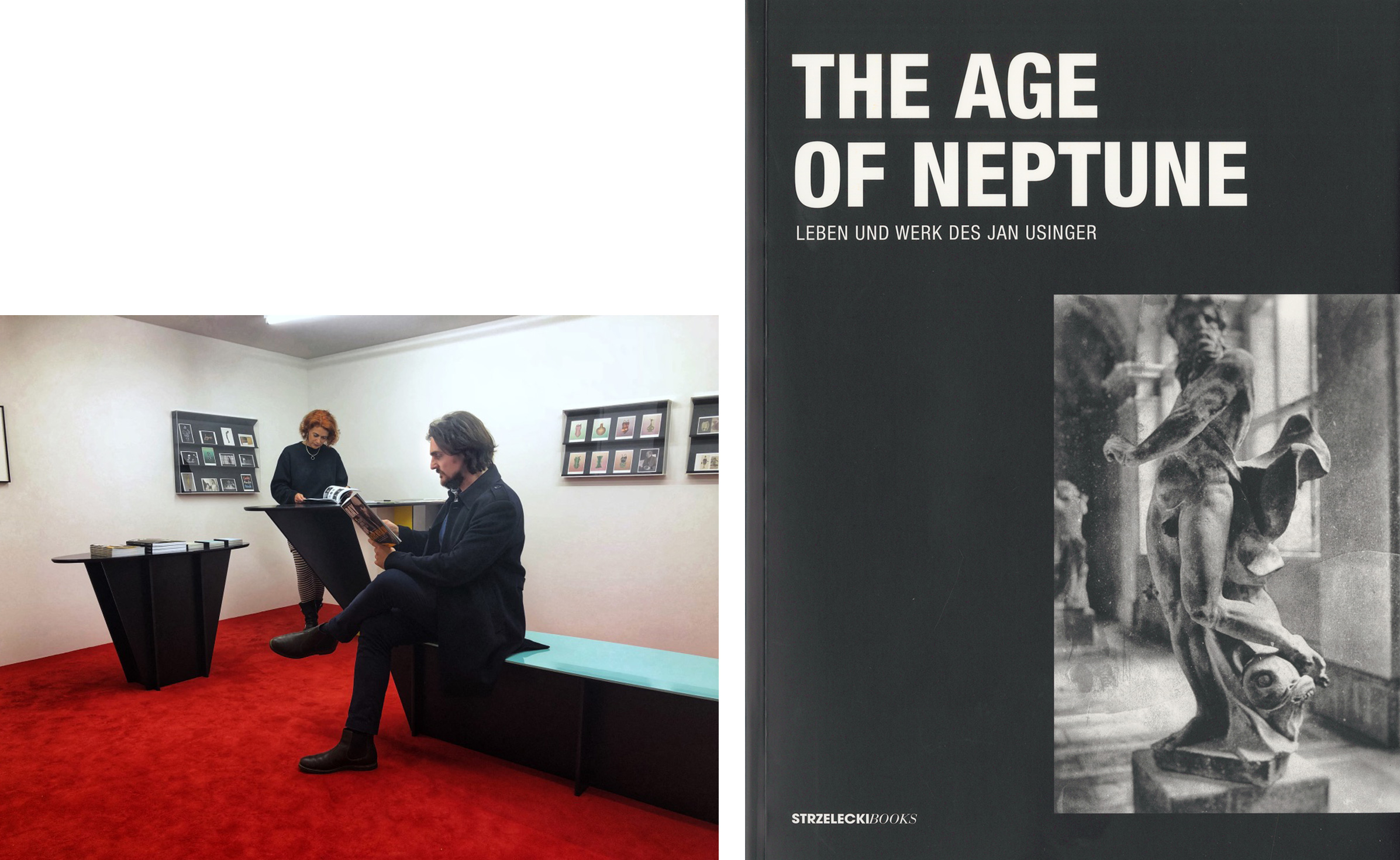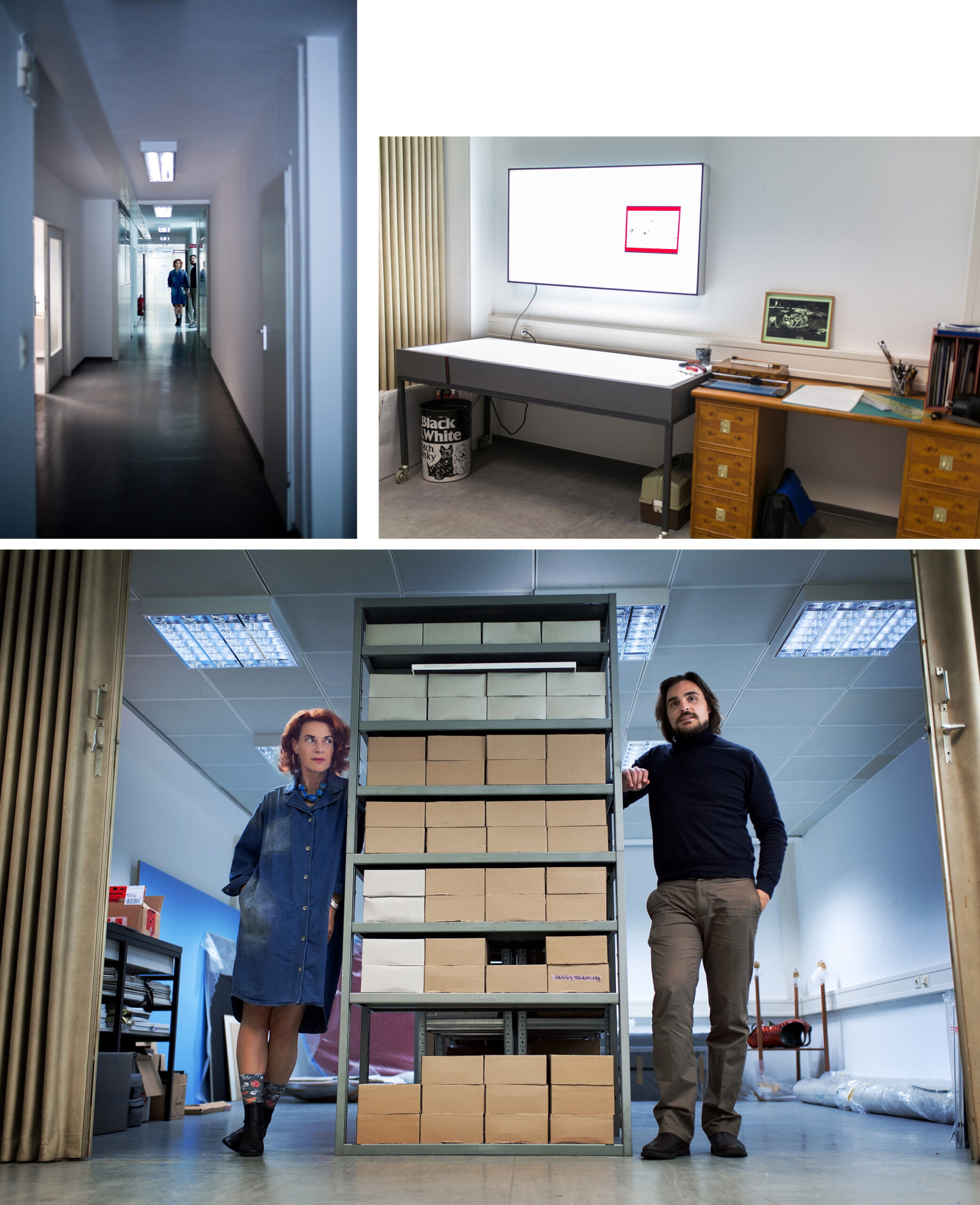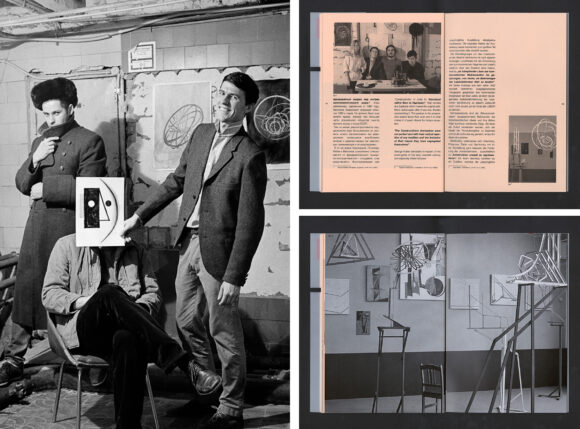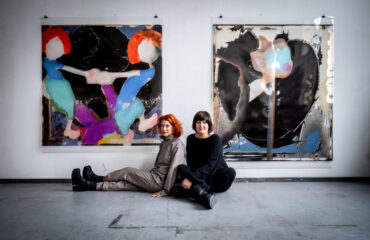Bonn/Düsseldorf, June 2018. None other than the artist for whom this exhibition is organised – Matthias Wollgast – accompanies me today through the exhibition “The Steps with no name” at the Kunstmuseum Bonn. Bonn Art Prize, Förderpreis für Bildende Kunst des Landes NRW, solo exhibitions in museums… it’s going quiet well for him right now. What is it that is making his work so special, which moves between painting, drawing, photography, sculpture, film, artist’s books and even furniture design?
It was his idea to meet at the exhibition before visiting the studio. To get a first impression, as unbiased as possible, I first go through alone. The beginning of the walk round already brings me to my first questions. A fancy little room, laid out with a red carpet, equipped with elegantly designed tables and a bench whose seat surface is coated with delicate high-gloss lacquer. Especially the laid out catalogue material and the postcards on the wall give the impression of a museum shop. But the cash desk is missing and somehow you also get the feeling that you are neither allowed to use the delicate bench nor to touch anything. But you are. You are even supposed to. Here are the publications that play an important role in Matthias Wollgast’s work. But we’ll get to that later.
<em>Store</em>: Carpet, MDF, acrylic glass, postcards, books, camera less photography (handcoloured), Inkjet-Print, paint, 2018, Photos: David Ertl
Around the corner we continue into a large area. On a strange grid device on the wall hangs the presumed model of the exhibition poster. The photography seems to be important. I go closer and am surprised to see that this is a painting that only looks like a photography from a distance.
<em>prop no.3</em>, 150 x 200 cm, Oil on canvas, 2017, photo: David Ertl
In the centre of the room is a typical archive shelf, equipped with boxes precisely matched to the shelf dimensions and stacked accurately on top of each other, as well as sculptures and objects from previous exhibitions. Is this supposed to be the recreation of a museum depot? Maybe the labels on the boxes will help me solve this mystery. Wordplay combinations such as “Aussichtslose Sachen”, “Schlecht besuchte Sonderausstellungen” or “Raffinierte Kunst” can be read as well as well-known terms from art history and art theory. A bit irritating, but amusing. The visibly untouched exterior construction of the presumed museum shop underlines the depot character of the large area. From this line of sight, in combination with the shelf, it looks like a stored shipping crate.
<em>WYSIWYG</em>, 210 x 400 x 100 cm, steel, wood, carton, paper, swimwear, epoxide resin, paint, colour, 2017 and <em>Store</em> s.a., photos: David Ertl
The third station in the room, which at first presents itself only from its rear side, contains a room replica on the inside. A dark laboratory, sterile and mysterious, with sounds of equipment in the background. So it’s a kind of stage again. And again you can find something familiar and mysterious in it. People who know Matthias Wollgast can already guess that a great story must also be connected with this scenery, which has been developed in collaboration with the scenographer David Schnaegelberger…
<em>Set I</em>, 270 x 350 x 300 cm, steel, wood, paint, colour, stainless steel, mirror disband, acrylic glass, LED, UV-lamp, tube, material, glass, various objects, books, succulent, 2018 (in collaboration with David Schnaegelberger), photos: David Ertl
The story of the fictitious artist group<em> Reconstructivists </em>in the context of Russian art of the 1970s was followed by the equally fictitious tragic story of the forgotten outsider artist Jan Usinger, whose previously unknown oeuvre was found in the attic of the Art History Institute of the University of Bonn before it could finally receive its late earned recognition.
These stories were “proven” and documented through fictitious historical archive material and works, which, in collaboration with real art historians, were then also placed in the art historical context. Important note: The academics knew what was going on and were really enjoying the production. The entire frame around the stories was developed down to the last detail by Matthias Wollgast, especially the fictitious works of art all produced by him.
<em>Extracts of OBMOKhU 79</em>, publication about the fictitious artist group<em> Reconstructivists</em>, 2014
<em>Examples of The Age of Neptune – Leben und Werk des Jan Usinger</em>, fictitious artist monograph, 2016
The latest project is the making-of for a film that does not exist. The title corresponds to the exhibition <em>The Steps with no Name</em>. The story is about the polar explorer Ray Mondt (depicted by Stefan Lampadius), who is forced by a light allergy to move from his research station at the North Pole into the darkness of a basement apartment in London. In the end, there is or will be almost everything that usually characterizes a making-of: excerpts from a script, storyboard, interviews, photos from the set, actors, posters, a magazine (which in this case is also the exhibition catalogue) and reviews. Just no film. The stage which has been set up here serves as a scenery for new ‘still pictures’ of a film that will be created during the current exhibition.
Examples of the Making-Of about <em>The Steps with no Name</em> (freeze frame 4, Inkjetprint, 2017 and Ray, publication, 2018, Layout: Edi Winarni)
As with the predecessors, this project will be concluded with a final publication. The artist book <em>The Age of Neptune – Leben und Werk des Jan Usinger is</em> available at the fictitious museum shop. Before we go to the studio, I take a look myself. Exactly following the pattern of a biographical artist portrait, it does not raise any questions about authenticity at first sight. With my new knowledge, however, I quickly sense a mixture of fun and awareness. Not only does the story reveal itself as the typical cliché of the overlooked artist, but also the entire design of the book as its own format with common structures and patterns that I have never doubted before.
The Age of Neptune – Leben und Werk des Jan Usinger, Publikation, 2016, Umschlaggestaltung: Edi Winarni
One thing is clear: When looking at Matthias Wollgast’s art, one should take a closer look. Obviously, nothing is what it seems at first sight. Thus, I carefully approach the postcards. Swimsuits and vases, but also familiar figures by Boccioni or Brancusi can be found as motifs. Liberated against a neutral background, cleanly contoured. Probably digitally created illustrations. I ask about it. The answer is, “No. The works were created by cameraless photography,” which moves us to the studio in Düsseldorf for a clearer explanation.
figure no.37/figure no.38, hand coloured silver gelatin deliver, ever 55 x 45 cm, 2015, figure no.1, hand coloured silver gelatin deliver, 55 x 45 cm, 2012
The interior of the building, in which Matthias Wollgast’s warehouse and studio are located, looks like an abandoned administrative office. Thus, we are confronted with a tremendous amount of bureaucratic drabness. The storage room, in which we hold our conversation, rounds off the picture. The light in this windowless room is provided by neon tubes. The floor is covered with PVC. A plastic folding door serves as a room divider. Behind this there is a large archive shelf. Hold on! Confusingly enough, it looks very similar to the one from the exhibition. Matthias Wollgast notices my expression and is obviously having fun: “I thought you would immediately notice the similarity. It’s only similar on the surface. The one inside the museum is completely made-to-measure, this one is a standard.”
In the depot of Matthias Wollgast, photos: Natascha Romboy
The lightboxes, which he now switches on, are helpful for demonstrating his cameraless photography. He attaches the negative to it, the positive of which he has shown me before. On closer inspection, the negative turns out to be the finest pencil drawing.
Positiv, dass durch ein gezeichnetes Negativ (s. Bleistiftzeichnung Bild 2) entstanden ist
“It’s actually very simple. I am the camera. An already developed photograph serves as a model for the new negative I have drawn, which is then developed in the usual photographic process. The coloured works that you just saw in the postcard print later developed from this idea,” he explains and also shows me examples of this. “A motif is transferred to films of different colours. Each individual colour shade requires its own foil cut.” He shows and explains the individual steps of the process in his studio room. It is astonishing to see that the digital impression is due to the finest artistic craftsmanship.
“Why such an effort, if it is not visible to the viewer,” I would like to know now.
Demonstration of the films-technic within the hand coloured works in the studio , photos: Natascha Romboy
“At first it was about appropriation, about the question of authorship. The first motifs I used in this technique did not come from me. Nevertheless, something new has emerged from these models that bears my artistic signature. Who’s the author then? Traditionally, as an artist you are always exposed to the challenge of having to create something new in art on your own. At the beginning of my artistic career – I come from painting – I also tried to fulfil this mission. Eventually I realised how unfree it made me. The turning away from painting and the gesture of appropriation of well-known motifs by the form of cameraless photography developed by me was a liberation for me at that time. I developed an increasingly strong interest in the structures and systematics of art and questioned their influence on our viewing and perception habits,” says Matthias Wollgast, revealing the background of the big picture, which now makes the connections plausible.
Even if the question of authorship is no longer the only focus, its reflection and the means of appropriation have become an integral part of Matthias Wollgast’s way of working. Using his <em>figures</em>, which were created by cameraless photography, or the collages of <em>Jan</em> Usinger, as an example, he makes it clear that a new work of art is generally not developed from within, but on the basis of references and appropriations, and thus exposes the artistic genius as a myth. And what happens in the development of a setting for his fictional stories? Here it is the structures, patterns and narratives surrounding art that he reflects on and emphasises by means of appropriation as a context that does not make us question the authenticity of art.
All in all, a truly complex concept that shows us our own patterns of perception in a subtle and humorous way. Simply genius!
More Information
… about the artist: http://www.matthias-wollgast.com/
… about his works in the Gallerie Rupert Pfab, Düsseldorf: http://www.galerie-pfab.com/de/artist/matthias_wollgast/works
… about his exhibition in the archive of the Kunstmuseum Bonn: http://www.kunstmuseum-bonn.de/ausstellungen/rueckblick/info/ex/bonner-kunstpreis-2017-3670/
… über den Ausstellungskatalog im Verlag für Moderne Kunst: https://vfmk.org/de/shop/matthias-wollgast
The Age of Neptune. Leben und Werk des Jan Usinger auf der Seite von Strzelecki Books: https://www.strzelecki-books.com/kunst/
… about the coming group exhibition in Museum Morsbroich in 2020: http://www.museum-morsbroich.de/
























